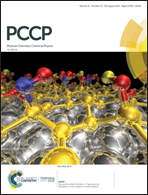Unoccupied electronic band structure of pentagonal Si nanoribbons on Ag(110)†
Abstract
Silicon nanoribbons – one dimensional silicon structures with a pentagonal atomic structure and mixed sp2- and sp3-hybridisation – grow on Ag(110) upon deposition of silicon. These nanostructures are viewed as promising candidates for modern day electronics as they are comprised of the same element as today's semiconductor devices. Even though they have been studied extensively over the last decade, only little is known about their unoccupied band structure which is important for possible future optoelectronics, semiconductor, and spintronics applications. In order to elucidate the unoccupied band structure of the nanoribbons, k-resolved inverse photoemission spectroscopy (KRIPES) studies were performed on both nanoribbon structures reported in the literature as well as on the bare Ag(110) substrate within the energy range of E − EF = 0–6.5 eV. The obtained experimental results are compared to density functional theory (DFT) calculated band structures to assign individual spectral features to specific bands. Since even small changes in the structural model of the nanoribbons lead to a change in the calculated band structure, this comparison allows us to assess the validity of the proposed structural models.



 Please wait while we load your content...
Please wait while we load your content...